If you want to become a digital nomad or long-term traveler, or are planning on going on a long trip, you might be thinking of starting a travel blog.
Some people think starting a brand new blog (and knowing how to monetize it) is easy and that it can cover your travel expenses within a few months. Other people are completely overwhelmed at the prospect and don’t know where to start.
I’m here to say that starting a travel blog is neither easy nor impossible; if you have the right information (ahem, like the information in this very article!), you too, can become a successful travel blogger.
In this guide, I outline all the steps you need to start your travel blog, as well as some more advanced things to consider, including monetization.
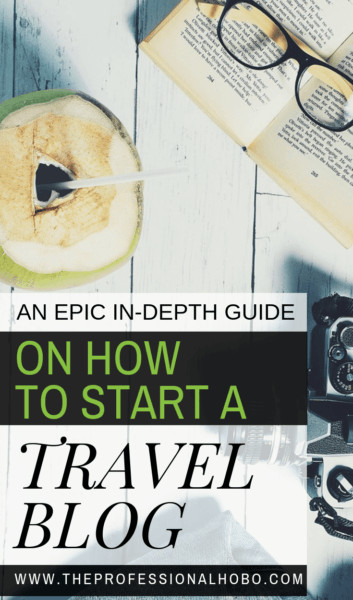
Table of Contents
Chapter 1: Establish Your Travel Blog Brand Identity
Chapter 2: How to Set Up Your Travel Blog on WordPress
Chapter 3: How to Write Your Travel Blog Posts
Chapter 4: Growing Your Travel Blog and Audience
Chapter 5: How to Monetize Your Travel Blog
Chapter 6: How to Get Sponsorships
Chapter 7: The Disadvantages of Travel Blogging
Chapter 8: Taking It to the Next Level (ie: Don’t Reinvent the Wheel!)
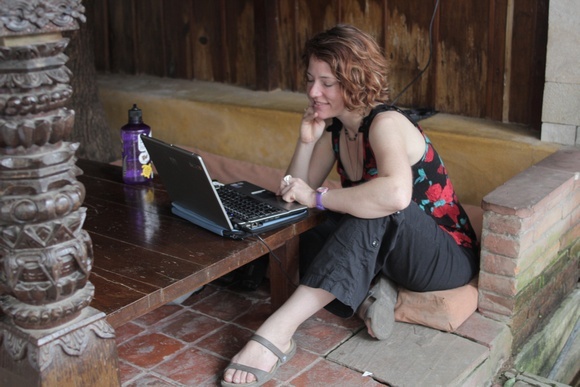
Chapter 1: Establish Your Travel Blog Brand Identity
The very first thing to do when you start your travel blog is to decide on your blog’s brand identity.
In this chapter, I’ll outline some tips on how to choose your niche and audience, and how to name your blog, as well as some mistakes I made when I first started out.
Choose a Niche
Travel blogs are a dime a dozen; just about anybody who takes off on a long trip has visions of regaling the world with their tales of travel – and hopefully making some money at it.
In order to differentiate yourself from these masses and make your blog worth visiting, find a niche you’re interested in exploring that you have (or can gain) some expertise in.
Tip: Do a little “market research”, see what’s out there already, especially in your area of expertise. See what’s missing. Decide what you like (and don’t like) about other sites, names, designs, and themes.
Once you have a niche, stick to it; this will help people see you as an expert. Plus, the more relevant your content is to your niche, the more loyal your (relevant) audience will be to you.
Know Your Audience
In developing your niche, you’ll also be developing a target audience. Know who you’re writing for, and tailor your content for them. You can’t be everything to everybody; if you get noticed by a certain segment of the population, you stand to become better known overall than if you try to cater to everybody.
And later on, monetizing and getting sponsorships will be infinitely easier when you can define your audience.
Pick a Name For Your Site
Choosing your blog name and domain is akin to choosing the name of your business; you want it to be catchy, easy to remember, and topical.
Changing your domain name is not easy (nor recommended) after the fact, so put some serious thought into what you want your blog to be about. Make it an easy name to remember and search.
Check your ideas to ensure the domain is available (don’t forget to ensure the related handles are available on social media too!), then purchase the domain and set up a hosting service and content management system. (More on this in the next chapter).
When I first started travel blogging, I made the mistake of choosing an obscure domain name (“freedom30”) which was a take-off on a little known Canadian commercial about retiring at the age of 55 (“freedom55”).
It wasn’t the worst domain name ever, but when I finally switched to a self-hosted site (more on this in the next chapter), I changed the domain to something that better reflected my personality and the subject matter of my blog. I set up redirects when I migrated everything over, but Freedom30 still haunts me from time to time.
Chapter 2: How to Set Up Your Travel Blog on WordPress
Once you’ve decided on your brand identity, it’s time to set up the actual site!
There are lots of options available online to set up a site. In this chapter, I guide you through the simple steps to get yourself up and running with your very own WordPress site.
Free or Self-Hosted Blogging Platform?
You can go with a free blog platform or a self-hosted blog platform.
There are a variety of free blog platforms out there (here’s a review of 16 such platforms); I started off with Blogger which is powered by Google. Probably the most popular free blog platform is WordPress.com (not to be confused with WordPress.org; more on this in a minute).
The advantage of a free blog platform is that it’s free. 0 commitment. If all you want is a travel journal that you have no intention of making money from, go for it.
But there are an abundance of cons to using a free blog platform.
For example, you get a cryptic web address (mine had “.blogspot.com” at the end), the platform often puts their own logos and ads on your site, it’s minimally customizable, and you can’t fully monetize your site (such as with ads or affiliate links). And – because you don’t own your URL, you don’t own the rights to your content; what’s worse: free platforms can shut down your blog at any time.
If you have any plans to take your blog beyond the status of a travel journal, you’ll need to go with self-hosting.
Buy Your Domain Name and Web Hosting
First, you need to buy a domain name. You can often do this from the web hosting company you plan to go with at the same time you buy your hosting (you can also buy them from separate companies, but this way keeps things simple).
I bought mine from HostGator, and it costs me $15/year. It’s dead easy to sign up and register your domain.
At this stage, it might be worth springing for the “Domain Privacy Protection”. I didn’t do this when I registered my domain name, which meant the domain registration information (including my name, permanent address, email, etc) became public information.
It increased the amount of spam I received, and I didn’t appreciate having all my personal information hanging out there in the breeze. It’s worth the extra $15 or so per year to keep this information private.
Use Promo Code PROHOBODEAL for up to 60% off hosting at HostGator!
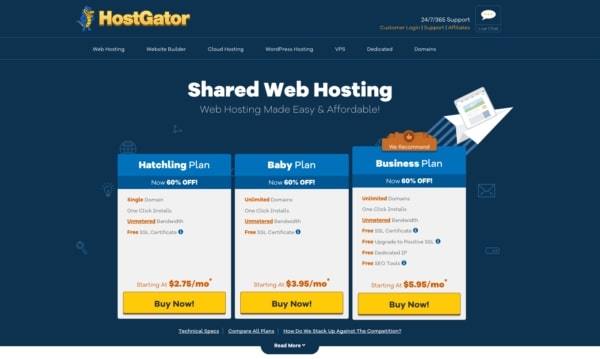
Then select your hosting plan. These can range from very cheap to very expensive depending on the company you go with and the plan level you choose.
At this stage, the basic plan should be fine for you. Don’t worry; you can change it down the road. I stayed on the Hatchling level with HostGator for years and it worked just fine.
Here’s the step-by-step to get your domain and hosting from HostGator:
- From the HostGator home page, click on the “Get Started” button, or on “Web Hosting” at the top. It will take you to this screen.
- The next page allows you to register a new domain name, or to apply a domain name you already own to your account. Further down, you can choose/confirm which hosting plan you want to go with (the longer you’re willing to commit, the more money you’ll save).
- Below that you’ll see some options for extras; don’t get caught up on add-ons for the moment – at this stage of the process, or any other stage where you see various premium options. You can always add that stuff later (often as a free plug-in option through WordPress), but at the moment you don’t know what you want or need, so don’t make it more complicated/expensive than it needs to be.
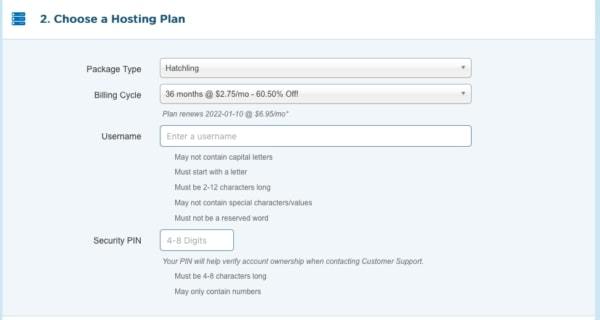
Because of my growing site and business, in 2017 I switched my hosting service to a company that specializes in managed WordPress hosting. Although it comes with a much higher price tag, it’s secure, fast, and includes a boatload of services that take the work – and worry – out of the tech side of managing my site.
HostGator was a great company for me to start out with, and I still highly recommend them. But once your blog is making some money and you want to outsource the tech stuff to ensure your site is in good hands, managed hosting is the way to go.
If you make a purchase through the HostGator links here, I will get a small commission. Thank you in advance for supporting The Professional Hobo!
Install WordPress
Now that you’ve got your real estate on the interwebs, you’ve got to actually build the house. To do this, you need what’s called a Content Management System, and that’s exactly what WordPress is.
Now here, we’re talking about WordPress.org, not .com. It’s free, totally customizable, user-friendly, and the most popular platform used on the internet.
Just like before, don’t worry about premium options – just install it, which you can do directly from the HostGator control panel.
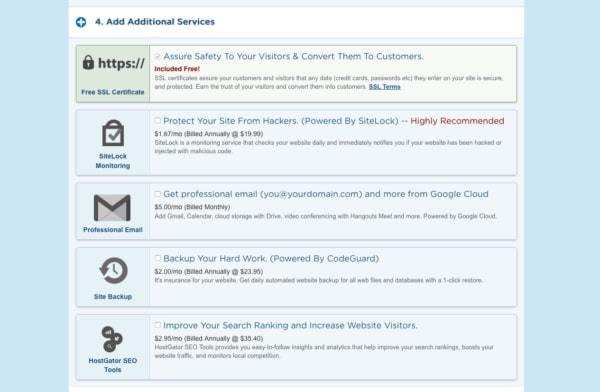
Click on Quick Install or Get Started With WordPress today. Don’t worry about the other icons – I don’t even know what they all do.
Prettify Your Travel Blog With a WordPress Theme
Once it’s installed, you’ll want to log into WordPress and acquaint yourself with your dashboard, which is where you’ll be doing all of your blogging work.
But before you can actually start blogging, you need to apply a theme.
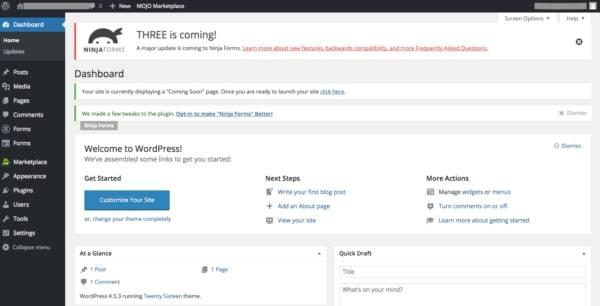
Under the Appearance menu on the left, you’ll find Themes. You’ll see free themes listed, and you can browse further (free and paid) themes.
Your research of other travel blogs will help you in choosing a theme that speaks to you. You can always change your theme later on, but I don’t recommend changing themes as often as your socks, since there are usually tweaks required to make everything work properly with a new theme. Choose one you like, and make it work.
I started out with a (few) free themes available on the WordPress dashboard, before hiring somebody to redesign my site in 2012. Big mistake: my designers used a premium theme they had a developer’s license for, and thus it was free for me (or rather, worked into their fee). Problems arose down the road when there were bugs with the theme and my designers had fallen off the face of the earth. The only way I could fix these serious bugs on my site was to buy the (very expensive) theme outright! And the theme just wasn’t worth it.
In 2017, I purchased (and absolutely adore!) my theme from StudioPress. These guys make quality customizable premium WordPress themes that are built on the “Genesis framework” (it’s like the supercar of themes). They’re mobile responsive, SEO friendly, easy to use, and don’t have the sort of heavy code that bogs down so many websites.
In 2021 I changed themes again. With ever-changing criteria coming down from the “Google Gods” that affect a site’s ability to appear in search results, new iterations tend to happen every few years in the blogging biz.
Check out the PlugIns
This is where WordPress shines; the vast availability of (and ease of installing and using) plugins.
From the Plugins menu you can browse and install all kinds of different plugins, to help you with adding pretty features, backing up your site, security, managing comments (especially the spammy ones), adding social sharing buttons, maximizing SEO, optimizing your site speed, etc.
At a minimum, I use and recommend the following:
- Antispam Bee (to filter out spam comments, which can number in the thousands)
- Subscribe to Comments (to allow readers who comment on a post to be notified if further comments are made; other popular comment managers include Disqus and CommentLuv)
- WordPress Database Backup (to automatically back up your site)
- Yoast SEO (to help with the SEO performance and searchability of your posts)
As your site gets bigger and you have more content to store, you might want to use plugins like WP SuperCache (to speed up your site), SumoMe (for social sharing and email optimization), and WP Optimize (to optimize your database size). The list goes on. Do a search for popular travel blog plugins and you’ll find a whole heap more.
You can – and will, trust me – spend hours searching various plugins and playing with them on your site. That’s okay.
But beware of having too many plugins, which will slow down your site and clog up your database, and can sometimes conflict with one another and cause problems with your site’s overall functionality.
So choose your plugins wisely, and if you aren’t using a plugin, delete it instead of just deactivating it. I have 14 plugins going at the moment, and that’s plenty.
Set Your Permalink
Before you publish any posts, I highly recommend carefully choosing your permalink settings. This is how your published posts will appear as a URL if you don’t customize each one.
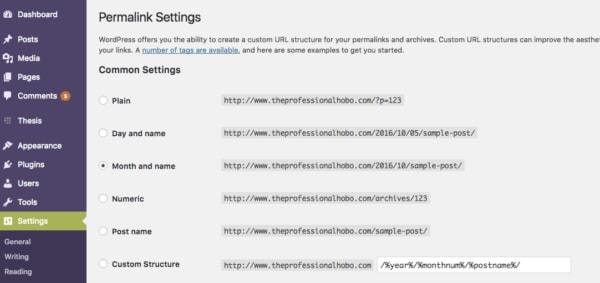
When I started, I made the mistake of choosing the “Month and Name” option, which was common for blogs at the time.
Unfortunately with this permalink structure, if somebody does a search and sees your post in the results, they’ll also see that perhaps the post is a few years old and they may not want to click on it, even if it is evergreen content.
If I had it all to do over again, I would choose the Post Name option for purposes of usability and longevity.
It’s important to set this early on – and not to change it – because changing it mid-stream changes the URLs of all the posts on your site. This will affect your search-ability, and anybody who has linked to your posts in the past will end up with broken links (unless you use a URL redirect plugin, which gets a bit complicated and slows down your site speed which affects your SEO).
Trust me….set it now, and don’t change it.
Create Pages and Posts
A Page in WordPress is a static web page that is usually connected to a menu bar at the top of your site (though it doesn’t have to be). You’ll see on my site underneath my logo at the top are a bunch of terms: About, Blog, Destination Map, etc. These are pages.
Posts are your regular travel blog entries and updates. Right now you’re reading a post.
Now is a good time to hash out the basic pages for your blog, like About, Travel Resources, Destinations, etc (basically how you wish to organize your website and content), before you start writing actual posts.
And now you’ve officially set up your travel blog on WordPress!
Chapter 3: How to Write Your Travel Blog Posts
Now that you’ve got your site set up, it’s time to get to the business of actually blogging!
There are a few important things that make writing for blogs unique, which you may not be aware of if you’ve never written for the internet before.
In this chapter, I outline a few things to make sure you do or include when writing for your blog.
Start Travel Blogging Well in Advance of Traveling
You don’t want to be futzing around learning the technicalities of blogging whilst on the road.
Also, if you have any intention of monetizing your travel blog or seeking sponsorships to subsidize your travels, you’ve got to have established content and a following, which takes time to build.
See Also: Before You Quit Your Day Job…
Post Regularly
Set a posting schedule and stick to it. Traditionally, the more often you post, the more traffic you’ll build, but don’t sacrifice quality for quantity.
Also, you might be full of ideas at the beginning, but bank some of them for later; it’s better to pace yourself and schedule posts in advance than to burn out too quickly. Posting once or twice per week is generally sufficient and sustainable.
Write About Something You’re Passionate About
It will be much easier to write regular posts if you’re passionate about the topic at hand.
This is one of the reasons why it’s important to select a good niche for you and your audience, and not just focus on what niche/topic is going to make you money.
I spoke to a travel blogger once who developed her site solely with an aim to monetize. To this end she did everything right, and she made some decent money – but she hated it. She felt like she’d sold her travel blogging soul, and eventually shut down the blog when she found something more inspirational to do.

Use Pictures
Pictures really do tell a thousand words, and internet readers lap them up (and Google likes it too).
Especially when it comes to travel blogging, it’s important to illustrate your story with photos.
Create Descriptive Titles
I used to write really abstract (I thought they were brilliant and artistic) titles, but they didn’t particularly serve me well.
Internet readers want to know what they’re going to get before they click on your article, so the more you can tell them in your title, the better the chances are they’ll click through.
This is also important from a search engine optimization (SEO) point of view; your keywords need to be in your post title.
Structure Posts for Scanners – I Mean, Readers
Most internet readers are scanners; they want to read your post without really having to read it.
Refrain from lengthy paragraphs, and organize your content with sections, subheadings, bolded text, and bullet points that make it easy for a reader to scan through your article to get a sense of what it’s about. If they like what they see/scan, they’ll take a closer look.
Chapter 4: Growing Your Travel Blog and Audience
Travel blogging isn’t just about writing your blog posts. You also want to have an audience who reads your blog.
If you don’t promote your blog, no one will find it on the internet, so this is an important step.
In this chapter, I go through a few different ways for you to (organically) grow your blog and readership.
Comment and Post on Other Travel Blogs
One way to build an audience is to get out there and gain exposure on other sites.
Know your industry by reading other travel blogs, and become a part of the travel blogging community by thoughtfully commenting on their posts.
As you network within travel blogging circles, you might get an opportunity to do a guest post or interview for another site – do it! This will provide exposure for your blog to a new audience, and will also provide valuable backlinks to your blog.
Work Social Media
Having a strong social media following is imperative to building an audience and eventually monetizing your travel blog.
Many of the sponsored trips and even the freelance writing gigs I land are contingent on my ability to use social media to get the message across.
Be aware that this can be an enjoyable – but slightly relentless – task, requiring you to post and interact with readers daily.
Personally, I work Facebook, Twitter, LinkedIN, and Instagram, Pinterest, and recently, even TikTok. Other social media networks include SnapChat, Mix, Flipboard, and others.
Taking it to the Next Level With an Email (Newsletter) List
It is said that an email list is the most valuable aspect of your website and online business.
An email list is a specially curated list of people who have opted in to receive your updates and news by email. These people are the most likely to buy anything you might eventually have to sell.
I didn’t start my newsletter until 2012 (and even then, somewhat begrudgingly so), but now I have a thriving community of almost 10,000 readers who receive my monthly updates, giveaways, discounts, and latest posts.
There are a variety of email newsletter services you can use; I used Aweber for years, before converting to a brand new service called BirdSend that is super simple, but ticked the boxes and saved me a ton of cash. Other popular choices include MailChimp, ConvertKit, and others.
Attend Industry Conferences and Events
There’s no doubt that you can up your travel blogging game by attending industry conferences like TBEX (Travel Blog Exchange), TravelCon, and joining associations like the SATW.

Chapter 5: How to Monetize Your Travel Blog
Many people start travel blogging with the hope that it will help subsidize their travels. Some even hope it will become their full-time gig.
Before that can happen, though, you need to put effort into monetizing your blog.
There are a few different ways to do this, some more effective than others. In this chapter, I outline some of the more impactful ways to monetize your blog as well as a few general tips to help you get started.
Build an Audience Before Monetizing
The best advice I got in my first year of blogging was when I asked an advertising dude how I could start to monetize my site; he said to simply keep blogging.
The reason he said this? No companies would be interested in advertising/sponsorship opportunities until I had an audience to speak of.
So instead of littering my travel blog with google ads and diluting my content with sponsored guest posts, I simply focused on pumping out quality content and building my audience. The rest came in time.
Monetizing with Sponsorships
Once you’ve got an established blog, audience, and social media following, sponsorship opportunities will open up.
These vary greatly depending on your travel blog’s niche and audience. I’ve gotten anything from free/discounted accommodation, to rail passes, to fully-paid trips. (More info in Chapter 6).
Select Advertising/Sponsorship Opportunities Carefully
Once your travel blog gains momentum and popularity, you’ll likely be contacted by all manner of people looking for text links, guest posting opportunities on your site, product reviews, and sidebar/banner ads.
Some of them will be relevant to your audience and niche, and many won’t. Some will pay well, and many won’t. Some pay flat fees, and others work on an affiliate or CPM basis.
Make sure that any advertising or sponsorship options you choose will ultimately serve your audience. If your travel blog is littered with irrelevant and distracting text links, badly written guest content, and if your sidebars are crammed with distracting ads, you’ll lose readers. Worse yet – you could be penalized by Google if you are linking to irrelevant websites (and not disclosing the sponsorship relationship); and a Google penalty is a death sentence in the blogging industry.
If you’re in the travel blogging game for the long haul, don’t go for the easy money if there isn’t a value offering in it for your readers.
Affiliate Sales
A really popular way to make money with your travel blog is through affiliate sales. When you recommend a product or service to your readers, you use a special link. When the reader clicks that link and buys anything from that store (which doesn’t even have to be the specific item you recommend), you earn a commission.
Amazon has a really popular affiliate sales program. Other programs (like Clickbank or ShareaSale) are aggregates of various stores; lastly, some vendors have their own private affiliate program.
There are two important things to remember when using affiliate links:
- Disclosure. On your website as well as social media updates, you must disclose affiliate links. Even in this very post you’ll see I’ve made some personal recommendations (like HostGator, Studiopress, and others), and nearby most links I include a note that I earn a small commission. I also have an affiliate disclosure in my site footer and Privacy Policy. Regulations around the disclosure of affiliate links often change, so make sure you’re up to date or you could face some serious penalties.
- Use with caution. I will only include an affiliate link for a product or service that I have personally used and can endorse. To my view, it’s a matter of credibility, and it’s not worth it for me to earn chump change on something a reader buys that they’re unhappy with, and then subsequently blame me for recommending.
Products/Services (Digital and Physical)
Not many travel bloggers make a full-time living with their travel blog alone. Some pad their income with consulting or social media marketing services, many produce digital products like e-books, and others work as freelance writers.
Many travel bloggers (myself included) employ a combination of income streams to pay the bills. (Here is a guide to 7 different ways to make money while you travel, other than blogging).
Once your travel blog’s niche is established, you can research what your audience needs through surveys and personal correspondence, and leverage your expertise to teach them what they want to know.
Perhaps you can design an online course, or write an e-book. Maybe you want to open up a coaching service. Or you can design physical products and sell them through a storefront.
Consider Freelance Writing
Freelance writing goes hand-in-hand with travel blogging nicely (assuming you’re a gifted writer); my travel blog serves as a portfolio of where I’ve been published, and I regularly feature other articles I’ve written.
In fact, I can command a high rate for online freelance articles because of my established reach and audience, and my ability to create valuable backlinks to other publications.
Not only that, but I can often incorporate valuable links back to my own travel blog from these publications I write for, which makes it a symbiotic (and profitable) relationship.
Multiple Income Streams
The most effective monetization strategy involves multiple streams of income.
The digital world is an ever-changing one, and focusing too much on any one income stream can be dangerous. One algorithm change on Google or FTC regulation adjustment could leave you scrambling. Don’t cast your net too wide across various income streams, but don’t focus too narrowly either.
Me? My travel blog income comes from a combination of affiliate sales, advertising, freelance writing, and digital product sales. For more information, check out my latest income and expense reports with detailed breakdowns and analyses.

Chapter 6: How to Get Sponsorships
Over the years I’ve gotten several questions and comments about traveling with the help of sponsorships: how to get them, portray them, and satisfy sponsorship requirements without diluting content or compromising your personal voice.
Let me first say this is a giant grey area, and nothing I say will be unanimously agreeable.
Everybody has a very different take on sponsorships and partnerships – those differences are part of our individual styles and preferences as travelers and entrepreneurs.
In this chapter, I outline what kind of sponsorships are available for travel bloggers, and how to get them.
My Experiences with Sponsorships
I have a fair bit of experience with sponsorships, from paid text links or sidebar banners, to free stays in hotels, various upgrades, free swag, transportation, tours, press trip events, etc.
Probably my three most involved sponsored travel experiences were my Aussie Train Pass (which I used to the max), the Ultimate Train Challenge (which involved coordinating a variety of sponsors to subsidize a 30-day multi-blogger event), and the Club Carlson Global Travelers experience which took me through eight European countries in three short weeks.
Before You Start, Have a Business with Influence
For travel expenses to be sponsored, you need a travel-related business that has a demonstrated influence on a target group of consumers.
In many cases the business in question is travel writing, either in the form of a travel blog or regular columns (or letters of assignment) for various publications.
Until you have an audience, don’t bother trying to get sponsorships. Instead, focus on the previous chapters of this guide and keep blogging.
Different Types of Sponsorships
Once you have an audience, some sponsorship opportunities will come to you.
These are normally proposals for sponsored posts, text links, and banners for your website. Some offers are better than others, and it’s up to you what’s acceptable. (Don’t be afraid to negotiate!)
Other sponsorships you’ll have to go digging for.
Here’s a list of potential types of sponsorships you might have access to:
- Sponsored Posts
- Website Banners or Links
- Free/discounted hotel stays
- Free/discounted transportation
- Free/discounted travel experiences/attractions
- Free all-inclusive trips (press trips)
- Travel gear
- Books for review
How to Pitch to a Sponsor for Your Travel Blog
For free or subsidized destination-based travel (for example you’re headed for “x” city/country and want to make the most of the experience), tourism bureaus and destination marketing organizations (DMOs) are great to approach.
Find the website in question, then search for press/media pages on the site. This often provides you with basic sponsorship information, and at the very least a media contact.
Once you have a contact (be it a tourism bureau or hotel manager or tour operator, depending on your needs), send them an email covering the following points:
- Who you are
- Your travel-related business
- The dates of your trip
- Who your audience is, with a quick summary of your influence and reach
- What you want from them
- How you plan to cover it (eg: through blog posts, videos, freelance articles, social media posts)
- Why this will be great for them (ie: you have an audience that is keenly interested in their destination/activity)
- Media page (see below)
Oh yes, and keep it short and to the point. They’re not interested in your life story.
Generally, the more notice you give them, the better. If you can provide a couple of months’ notice, you’re more likely to receive an offer for a fully-subsidized press trip with activities all covered.
Your Media Kit
Your media kit is an essential component to acquiring sponsorships of all kinds. It’s a one or two-page document or a page on your website that you can send to media contacts.
It provides a quick summary of your site and audience, with detailed information on the demographics, reach, unique visitors, page rank and ratings, social media followings, etc. Once you have some sponsored experiences under your belt, include testimonials from sponsors of how amazing you are to work with!
Disclosure and Promotion
Prior to the sponsorship taking place, make sure everybody is clear on how the sponsorship will be disclosed and what promotional activity will take place.
I’ve had agreements that stipulate details as minute as how many tweets I’d write and the exact number of links I’d provide across however many posts. Other agreements are more undefined, utilizing a certain amount of good faith.
The degree of disclosure you provide is dependent on the sponsorship itself, and how you are portraying it. But generally you need to disclose to your audience if you have been compensated in any way, including receiving something for free.
Following Up After the Promotion
It’s important to follow up by showing your sponsors how effectively you’ve covered the event/destination/gear/etc.
Send them links to posts/articles you produce, and tag their Twitter and Facebook pages in your social media posts and status updates.
For more involved sponsorships, you may need to send a summary report after the fact, illustrating the visitors/tweets/Facebook shares/etc for each related post.
The tourism bureau world is a small one, and it behooves you to nurture each and every relationship you have in the travel industry, making sure to meet (preferably exceed) expectations.
What to do if Your Sponsored Experience was Bad
Sometimes the experience/product isn’t good. What do you do? This is another grey area.
If a sponsorship goes badly, I usually email my contact and say so. If it’s something they can fix or that will change over time, I’d rather write nothing at all than say something bad, and most often they’re happy to keep it that way as well.
But then again sometimes it’s good to warn readers if there’s a legitimate ongoing problem that could affect their own experience.
This boils down to communication with your sponsor – during both the approach and follow up – to ensure expectations are properly set and met on both sides.
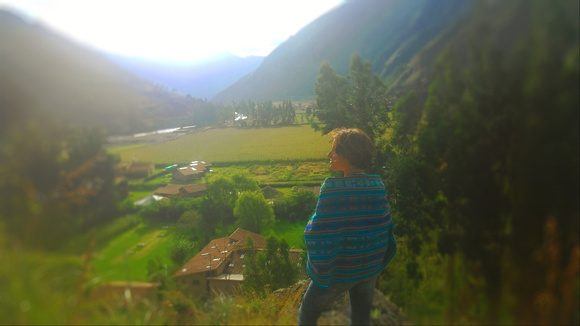
Chapter 7: The Disadvantages of Travel Blogging
Now, you might be thinking, why is Nora telling me about the downfalls of travel blogging in a guide all about how to start doing it?
Well, because travel blogging isn’t for everyone.
As with any career, there are disadvantages to travel blogging that may prevent you from enjoying it – or your travels – down the road.
In this chapter, I go over some of those downfalls and my experiences with them, to help you decide more clearly if travel blogging is something you really want to pursue.
Travel Blogging Takes a Lot of Work
Not only is there the initial set up that we covered in Chapters 1 and 2, but there’s also the time it takes to write, take pictures, upload, format, and publicize your posts.
Then there’s the possibility of your site crashing, or being hacked, or a glitch popping up, which you’ll have to take the time and effort to sort through.
Besides all that, you’ll probably develop a sense of obligation to your site, even if you’re not making money with it.
You’ll eventually find you’ve committed to your blog, be it the “need” to write x posts per week, or photoshop your pictures to perfection, or are taking an interest in other travel blogs to hone your craft. Unfortunately, this commitment to your blog is likely at the expense of some aspect of your travels (or relationships).
You Have to Be Online Way More Than Most People
Because a travel blog is a location independent business, you need to stay connected to the internet to keep it running and maintain it. This may even limit where you choose to travel to or what you end up doing!
And as liberating as it is to be able to work online from anywhere, it can’t really be anywhere. The need for speedy internet can have an impact on the destinations you choose.
Not only does your blog create an invisible umbilical cord between you and the internet, you’ll also be spending more time online than you anticipate.
Balancing Travel and Work is Difficult
Travel blogging requires a balance between actually traveling and writing about it.
It can be tricky to finesse, and you might not get it right the first few times you try. In fact, to this very day, work-life-travel balance is the most difficult part of my own online career.
More than once, I’ve had couchsurfing hosts who asked me why I traveled to their country only to spend so much time on my computer; they had no understanding that I’m not on vacation – I actually have a full-time job concurrent to my travel lifestyle. There’s nothing wrong with it, but it’s a different type of travel than you – and others – might be used to.
This is why I prefer to travel slowly, and to enjoy other forms of (free or cheap) accommodation like house-sitting; it allows time for work as well as a more in-depth discovery of the world on my proverbial doorstep.
Travel Partners Will Be Impacted Too
If you’re traveling with another person, be it a romantic partner, travel buddy, or family member, and they aren’t also blogging or running an online business, your time on the computer can cause friction.
For example, your work might not look like “work” to someone who doesn’t understand the industry. It’s happened to me multiple times. I’ve even been accused by partners of “playing on my computer” – even when my “playing” paid their bills!
This has led to resentment on one or both of our parts, sometimes fights, and sometimes even breakups. (See also: My Sordid Attempts at Finding Love on the Road).
It’s Not The Most Financially Rewarding
If your blog isn’t well-established before you start traveling, don’t expect it to pay for your travels right away. Even the most internet-savvy of travel bloggers don’t make money with their blog for months (sometimes years).
When you do start negotiating sponsorships, you may find yourself compromising your vision. Some travel bloggers accept poorly-written guest posts from advertisers who want random link exposure. Other bloggers write boring hotel reviews just so they can get a free night’s stay.
Although these bloggers might be making (some) money, it’s still a lot of work to communicate with advertisers and hoteliers, upload shoddily written guest posts, and write yet another hotel review. And chances are, this is not why you were initially interested in blogging – or traveling – to begin with.
Even so, travel bloggers rarely make their living solely from their blogs. Refer to Chapter 5 for the various ways travel bloggers tend to complement their blog income. Whether it’s freelance writing, coaching, web development, marketing, leading tours, or another form of income entirely, a travel blog is just a part of the picture.
None of this is to say that you shouldn’t start a travel blog. My goal here is to help you get a more complete picture of the lifestyle than you might have gotten so far, to help you decide if it’s really something you want to invest time and effort (and money) into.
Chapter 8 – Taking It to the Next Level (ie: Don’t Reinvent the Wheel!)
Want to make money blogging?
Join the club. A new travel blog is born about every 38 seconds, and a good percentage of the people behind those blogs think they’re destined for fame and fortune. Some might even presume that it’s easy money.
It’s not.
But the good news is, now there’s a tool – Superstar Blogging – to help you make money blogging, and it will gently take you from getting started to making money – much faster than it took me to do with my own blog.
I’ve been blogging for well over 12 years, and I wish this was available to me when I got started. I spent thousands of dollars in a haphazard way to design and redesign (and redesign again) my site and to learn the ropes of promotion and monetization – but I never got real advice as to what works and what doesn’t. I constantly felt like I was shooting in the dark.
So I did a lot of things wrong, and I learned everything the hard way.
But The Superstar Blogging school and mentorship program will give you everything you need to create a profitable blog – whether it’s in the travel niche or another niche entirely.
Note: The links in this chapter are all affiliate links. This means I will earn a small commission if you make a purchase. I have personally reviewed the content and I stand by it 100%. If I were getting started in the business right now, I would totally invest in these courses.
Superstar Blogging
Superstar Blogging is Nomadic Matt’s multi-faceted school with a number of courses on offer to help you start – and make money with – a travel blog. He parlays his 13+ years of blogging experience (and his annual high-6-figure success, I might add) as well as advice from and interviews with a number of industry professionals to create some slick material.
The Business of Travel Blogging
The Business of Travel Blogging was first released in 2016, and has since been updated and revamped. I audited the original course and each of these updates. Even with 10 years of blogging experience at the time, I learned a ton from it. Imagine how much you could learn if you were just getting started.
In March 2020, Matt completely redesigned and relaunched the course. Now, it’s not just an online course; it’s a mentorship program.
Superstar Blogging Courses
For the Business of Blogging course, here’s what is covered:
- The how and why of blogging – Get a deeper perspective on blogging with the story of how Matt started, lessons from over a decade of experience, and underlining principles so you can better serve your readers and learn what can elevate you above the noise.
- Mastering the tech stuff – Matt’s team will help you master WordPress and turn you into a tech whiz!
- Creating a lasting brand that people will remember – Learn how to stand out from the crowd and leave an impression among your readers.
- Writing content people want to read and share – Through detailed examples, you’ll learn how to write blogs people want to read and share online.
- Optimizing your website and ranking high in search engines – How you can outrank your competition and land on the first page of Google.
- Crushing it on social media – Learn how to get heard above the noise.
- Getting press coverage and become a source for writers – Learn how to become a resource for journalists and get featured in major online publications.
- Growing your email list – Email is the best way to reach your audience and you’ll learn Matt’s tips and secret hacks on how to supersize your email list.
- Making enough money to support yourself – All the high-impact ways you can monetize your website and create a business that will sustain you for years.
That’s Cool. But Here’s How the Superstar Blogging Course SHINES
I currently pay almost $100/month for tech support on my website. This is one of (many) perks included with your Business of Blogging membership (which incidentally costs less than half of what I’m paying):
- Weekly Q&As and Strategy Calls
- Unlimited Tech Support (“You break it, we fix it” is their motto!)
- Notes and edits on your writing––personal writing feedback!
- A community forum to interact and network with other students
- Bonus webinars from the most successful online creators in the world
- Real-world assignments to keep you motivated
- Lifetime updates so you can have access to the latest best practices
Business of Blogging Webinar with Matt & Nora
On the release of Matt’s newly designed course, and while we were both sitting at home in self-isolation, we turned on the cameras and recorded a live webinar, discussing the Business of Blogging.
You can watch it here!
Points of interest include:
03:40 – How do you manage all the tasks of blogging?
06:50 – How early in a blogging career do you hire staff?
09:50 – The importance of re-investing into your blog.
11:30 – Is a personality-centric blogging model still relevant and monetizeable?
14:40 – The difference between 2008 (when Matt and I started our blogs) and now, and what somebody starting now needs to consider.
16:50 – State of the “influencer” industry, and which social platforms we each use.
21:20 – The future of travel blogging post-pandemic, and when the best time to start a travel blog is.
27:40 – The first piece of advice Matt has for somebody starting a blog.
31:00 – Where to find virtual assistants, and hiring tips.
34:40 – Video blogging vs. Written blogs.
36:25 – Dealing with content theft.
38:40 – How to earn affiliate income, and our preferred affiliate providers.
41:00 – A wee rant about Amazon and how they’ve changed the affiliate game, and what can be learned from it.
44:20 – The various ways to monetize a blog, and the importance of creating products for your community.
48:40 – The future of sponsored content.
50:30 – How to get answers to all the rest of your questions about blogging, newbie and experienced alike.
The Bottom Line
I’ve said it earlier, but it bears repeating: I wish I had access to the Superstar Blogging School when I got started with blogging. It would have saved me thousands of dollars – and the equivalent number of hours – learning all this stuff the hard way.
And you can take comfort in the 14-day free trial and the cancel any time policy (you lose access to the course at the end of the month in which you cancel).
So…are you really interested to make money blogging for business? Well then….what are you waiting for?
According to Matt:
“If you want free information, go Google it. But if you want mentorship and free tech support and weekly strategy calls and feedback on your writing, come join Superstar Blogging; we’ll give you all that, PLUS all the information you want.”
Conclusion
So there you have it. That’s my complete and easy guide on how to start a travel blog.
What do you think? Do you have a travel blog, or are you thinking of starting one? Let me know in the comments below!
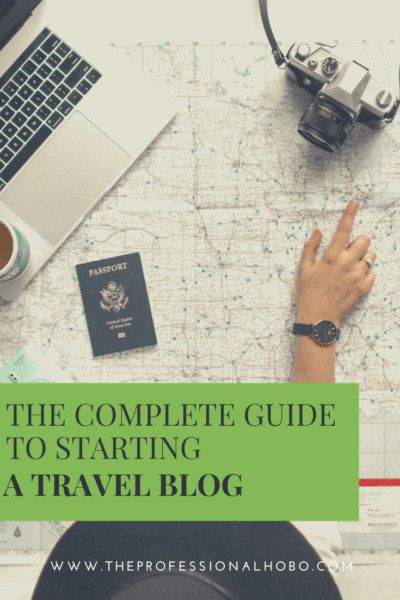
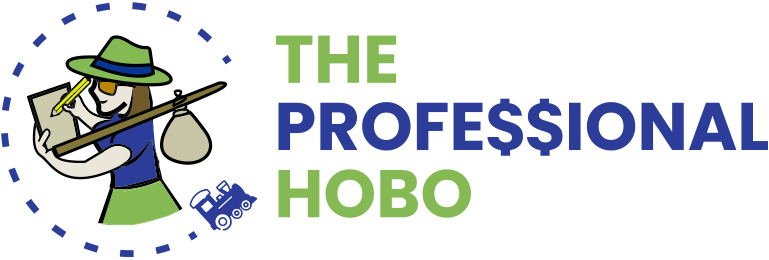
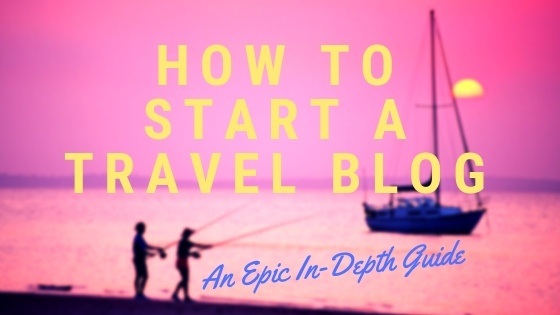

Thanks for giving these awesome suggestions.
It will help my blogging in future.
With pleasure, Wilfred! Please share this post if you find it useful.
Dannnnnng Nora! You have been putting out some stellar guides lately! Nice. I hope all is going well in Toronto! 🙂
Thanks, Tiff! Glad you’re digging the guides. It’s a great way to clean up so many bits of scattered content on my site that nobody would otherwise find and consolidate it into KILLER content. 🙂
So in-depth and informative! This is really helpful
Thank you, Juan!
Very informative! And the bit about shooting in the dark? Spot on! ?
Hey Nora! These guides are very cool! Your blog gives so much knowledge, it’s pretty awesome.
Many thanks, Ken!
Thank you for all of the detailed information! I just launched my family travel blog and will be using your advice:)
Excellent! Happy travel blogging! 🙂
Hi, I was late when I launched my blog, your tips are very helpful for us, first-time blogger. Do you have any tips for Squarespace plugins?
Hi Meika,
Sorry – I have absolutely no experience with Squarespace. Good luck! 🙂
Thanks for the reply Nora, yeah good luck for me. God Speed!
It’s been a year I started my blog. Covering some travel posts too along with DIY and Parenting guides. Your Post on starting a travel blog will surely help me and new bloggers who have just started their journey. Making a sustainable income is what thrives most.
Hey Mama Pirate,
Awesome – happy blog-building! It can be a slog, but also very rewarding.
This is a great step by step guide. I wish I could get more information on what themes to use. The free themes on wordpress seem cheap looking.
Hi Peter,
I agree, the free WordPress themes aren’t great. I highly recommend StudioPress…they make amazing themes! Here’s a link to get you started: https://tinyurl.com/y5s538zu
(If you purchase a theme through this link – which is also used in the article above, I will earn a wee commission. I personally use StudioPress and highly recommend them. Thanks for supporting my site!)
Don’t ask why, but to me, choosing a niche is the most fun part of creating a blog. Probably because I don’t consider myself a writer per se, so the research of finding the niche is interesting.
Hey James,
Perhaps you could turn your research/niche-finding skills into its own business! You could help others find and develop their niches…..
Yep, I have to do some big digging to find a good hosting company, host gator works just amazing.
Guess What i have spent 1 week in choosing niche but still i couldn’t get to any conclusion but after reading your blog i’ll be considering travel as a nich. But still i am confused. Can you please suggest some good niche?
Thank you,
Hi Rahul,
The best niche for you depends on what you’re knowledgeable and passionate about, which is also hopefully something that a group of people want to know more about.
But first and foremost, it has to be something that you want to focus on and write about!
Hostgator worked flawlessly, thanks for sharing that 60% coupon, Saved some extra money for the weekend.i will try to post articles on a weekly basis got a free SSL as well.
Hi Maria,
Thank you for using my coupon and link! I’m glad you are happy with HostGator. 🙂
Once you have some sponsored experiences under your belt, include testimonials from sponsors of how amazing you are to work with!
Great advice, Dibble! I include this in my press kit.
Thanks for the insight. That was a very in-depth guide.
Very informative Nora! I’ve had my blog for a while but lot’s of great stuff to digest, thank you!
It literally took me 3 days and a notebook to gulp down all the information. Thank you so much for sharing with us.
Very informative Nora! This is a great step by step guide.Thank you so much for sharing with us.
Very informative Nora! I’ve had my blog for a while but lot’s of great stuff to digest, thank you!
Hey Nora! These guides are very cool! Your blog gives so much knowledge, it’s pretty awesome.
Hi, Nora! Thank you for sharing this valuable information with us. In 2016, I took a sabbatic year with my 6 year and fell in love with the world. Unfortunately, I didn’t know much about blogging at that time, we only kept a FB page (Maya in Wanderland) which was our travel diary. I wish I had taken the time to write down all our experiences in a blog and give back to the world what the world had given to us.
Now, I’ve decided to develop a travel project in my home country, Romania. I attached a blog to it, but as you say, it’s not an easy job to post constantly and consistently. If you happen to visit Romania in the future, as I’ve seen you haven’t so far, do get in touch with me. It would be lovely to meet you and maybe I can assist you with your travels while in the country. All the best to you, Cezarina
Thanks, Cezarina. I’ll let you know when I’m in Romania!
Lots of good points made. I especially like that you covered the not-so-fun side of travel blogging. It’s definitely hard work and while it IS a fun path to take in life, there are downsides to everything.
Thanks, Kelli!
I believe in telling the whole story; good, bad, and otherwise. It helps us make the right decisions overall, because indeed – everything has a cost.
I always wanted to start a travel blog, but I`m hesitant to make one because I don`t know where should I start with. Luckily I found this travel blog guide. Thanks for the information Nora, this will really help me a lot.
I’m glad it helped, Charlie. Thanks!
Thanks Nora for the comprehensive guide. This’s as detailed as it can get. It’s a common mistake with starters, trying to chase every popular idea out there- I’ve been there. But niching down a blog isn’t just good for the audience, it’s very important for SEO nowadays.
You’re so right, Sydney! We can’t be all things to all people; I believe specializing creates a more successful (and rewarding) career.
Hi Nora,
Thanks for coming with this article. I am actually on the verge of “to buy or not to buy” :). Now I made a decision to buy my own domain and get serious of blogging.
Hostgator worked flawlessly, thanks for sharing that 60% coupon, Saved some extra money for the weekend.i will try to post articles on a weekly basis got a free SSL as well.
Thanks Nora for the comprehensive guide. This’s as detailed as it can get. It’s a common mistake with starters, trying to chase every popular idea out there- I’ve been there. But niching down a blog isn’t just good for the audience, it’s very important for SEO nowadays.
Thank you Hendrix! Indeed, niches are where it’s at.
Yeah it certainly not easy to travel all around the world only some of us can able to do so, thankyou for putting together a comprehensive guide 🙂
A fantastic, in-depth post Nora. We’re in the process of growing our IG following and this guide will help us take things to the next level.
I like traveling a lot and I’m thinking of starting a travel blog. Thanks a lot for this. Very helpful!
I like your sincerity about travel blogging. Because we mostly see someone in a beautiful landscape and a laptop, it’s easy to think it’s an “easy” work. I’m definetly inspired to start one!
I laughed with you– and nodded my head. Thanks for being “real” with your readers. And I’m glad you explained the text links..I’ve started getting so many requests for those and it gives me anxiety, too!
This is awesome! Bookmarking for later. Gonna have to review this one a few times.
Thanks for this blog post, Nora! Really helpful, especially to new travel bloggers.
This is a massive guide. It must have taken ages to write. It seems from the comments that everyone has found it useful. On the question of themes, on my own blog I use DIY Themes. It’s not cheap but build with speed in mind (a must with googles UX update) for hosting I can also recommend WPX. Very very fast and brilliant support. I also notice that you are using a table of contents. I think that this is a must with such an in-depth guide. Well done and good luck to everyone else.
Thanks Caraman. I hear DIY Themes are great. Haven’t heard of WPX.
Hi, Nora, thank you for sharing this honest list. I liked reading the disavantages of travel blogging, because we daily see tons of all-good situations and places on social media that we can easily forget the other side. I like traveling and sharing my impressions on a blog seems an extra motivation.
It’s a really comprehensive blog. I appreciate how you explain and write about how to start a blog and your honesty in revealing the drawbacks of blogging. This article is really useful, particularly for aspiring travel bloggers.
Just like any thing worth doing starting a travel blog will take some time and you must trust the process. I would totally agree that using wordpress is a good idea as it does most of the content management for you, and should you want a new look you can always change the theme. A lot easier and less expensive than web design.